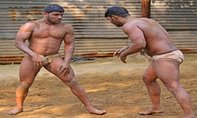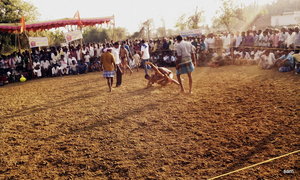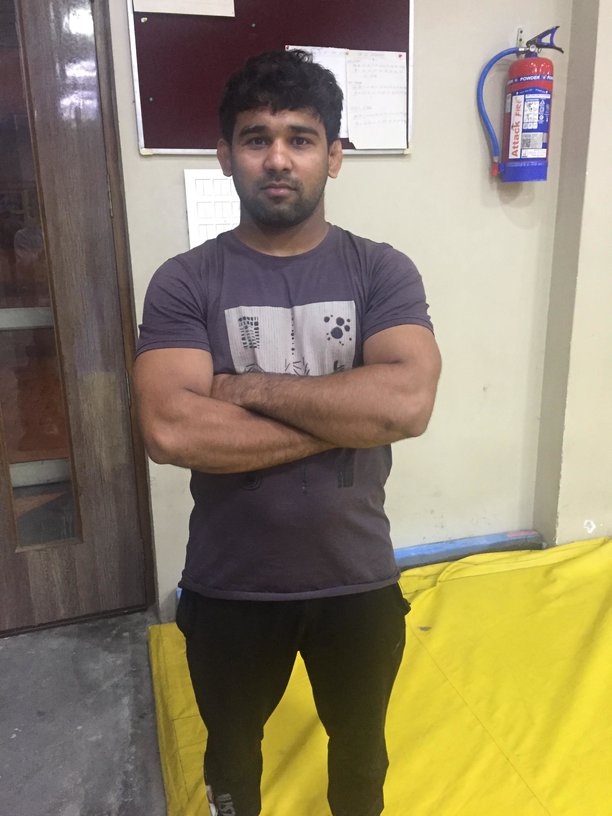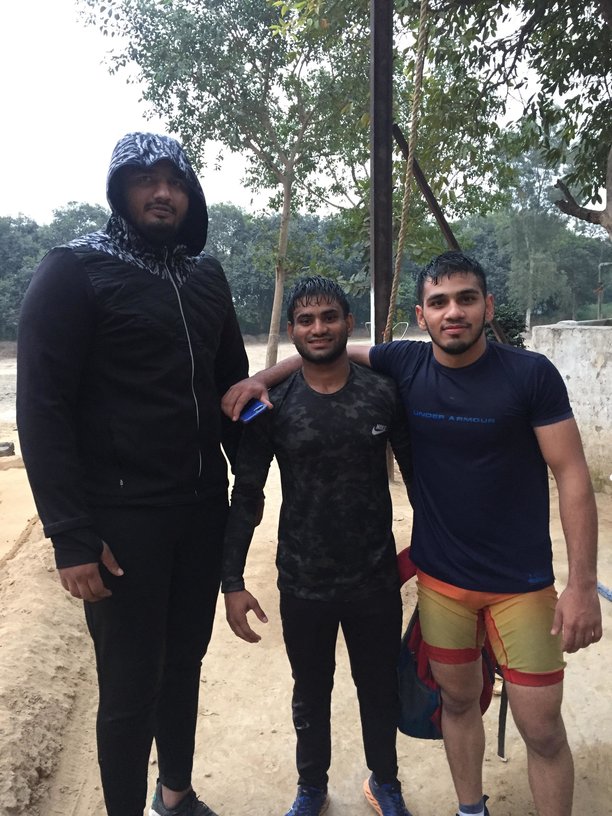- About Us
- Columns
- Letters
- Cartoons
- The Udder Limits
- Archives
- Ezy Reading Archive
- 2024 Cud Archives
- 2023 Cud Archives
- 2022 Cud Archives
- 2021 Cud Archives
- 2020 Cud Archives
- 2015-2019
- 2010-2014
- 2004-2009
 |
(May 2020) Grappling with the Kushti: |
“This is where we fight,” said Manjeet. He was muscular and stocky with swollen cauliflower ears, a prominent scar on his nose and kind eyes. We were standing next to a large, rectangular sandpit with a carefully manicured and smooth surface. “And that,” he said, pointing down at a grassless dirt field below us, “is where we train. Every morning.”
I was at the Master Chandgiram Akhara, an unassuming compound with high cream-colored walls about ten minutes by tuk-tuk from the Kashmere Gate in northern Delhi. It is one of the premier training centers for aspiring kushti — practitioners of a traditional form of mud wrestling popular in the Indian subcontinent.
It is one of the premier training centers for aspiring kushti — practitioners of a traditional form of mud wrestling popular in the Indian subcontinent.
I approached the compound tentatively; unsure of the reception I would receive. The tuk-tuk driver had not inspired confidence. “You want to become kushti?” he asked, confused.
“No,” I said. “I just want to watch.”
“Want to watch? You have a friend who is kushti?”
I replied I didn’t.
“So why you want to watch?”
I paused at the entrance and knocked. The heavy door creaked open and I was greeted by the friendly smile of Manjeet. His powerful warrior physique and reserved manner combined to create the impression of someone who would have been able to quietly neutralize me a dozen different ways within seconds. I explained I was interested to learn about the kushti way of life. He smiled and offered to show me around. He had never met an Australian before.
Combat wrestling has been popular in South Asia for thousands of years. The modern version practiced at the Master Chandgiram Akhara derives from an ancient tradition called malla-yuddha. There are no rounds and no point scoring system. To win, a competitor must pin his opponent's shoulders and hips to the ground simultaneously. It’s brutally tough, with bouts often running for over thirty minutes. Mud wrestling is a very popular spectator sport and success as a kushti can result in becoming a household name throughout India.
As teenagers, young men who aspire to become kushti enroll in akharas and follow a strict regime of intense physical training fused with elements of yoga and philosophy. Kushti adhere to an ascetic lifestyle of clean eating and living. Alcohol, tobacco and sex are forbidden.
Manjeet and his fellow kushti don’t confine themselves to the traditional form of Indian mud wrestling, but also train in freestyle wrestling as seen in the Olympics and Commonwealth Games. Indeed, the Master Chandgiram Akhara was established by the renowned Chandgi Ram, a man who won a gold medal in the 1970 Asian Games and represented India in the 1972 Summer Olympics.
We walked into a vast room with wrestling mats on the floor. Two gigantic men were stretching in laced up shoes and skin-tight one-pieces. Manjeet explained in broken English that they were twins and famous throughout India as champion wrestlers and Bollywood stars.
The next stop was the gym, a spartan room with a squat rack, bench press, pull up bar and a selection of battered free weights. It had no mirrors, no speakers and nothing on the walls. No one was around. “Where is everyone?” I asked. “Resting,” said Manjeet. “We train in the morning and afternoon. Middle of the day is for rest.” It was around lunchtime.
He took me around the back and we went past the living quarters — austere rooms filled with bunk beds, communal bathrooms and showers. I asked Manjeet if I could come and watch their next training session. “Of course,” he said, smiling. “We train from four to six this afternoon inside on the mats. Welcome to watch.” I thanked him and agreed to come back then.
Horrific peak hour traffic in Delhi meant I didn’t get back to the akhara until almost five. By then, the room with the mats was full of boys and men practicing. Sweat was pouring off them as they contorted and writhed, each trying to grapple his partner into submission. Manjeet was running the session and pacing around, barking commands in Hindi and blowing on a whis tle. He would occasionally stop to assist a pair, making suggestions and adjusting their hands to improve their technique.
tle. He would occasionally stop to assist a pair, making suggestions and adjusting their hands to improve their technique.
During a break for water, a burly young guy with thick eyebrows and a strong jawline came up to me and introduced himself as Jatin. He was eighteen and had been living as a kushti for five years. I asked him about his training routine and he motioned for me to follow him outside. He took me to the sandpit Manjeet had shown me that morning. Jatin explained that water is added every few days to keep it at the right consistency. It needs to be soft enough to avoid injury but hard enough so as not to impede the wrestlers' movements.
Next to the pit were a number of ropes supported by a beam about ten meters off the ground. I asked Jatin whether he could climb one of the ropes. In a flash and with remarkable ease, he hauled himself to the top using only his arms. “I can do fifty of those,” he said. My eyes widened.
As Jatin descended the rope, a colossus in a black tracksuit appeared behind me. I swiveled around and looked up. His name was Kuldeep and he stood at six foot six inches and three hundred and ten pounds (one hundred and forty kilograms). He was nineteen, had spent four years as a kushti and was the number one ranked superheavyweight wrestler in Delhi. Trailing Kuldeep was his friend, Himanshu.
The three of them spoke of their schedule with pride: they trained six days a week and started at four am, with only Sunday off. I asked what they did on Sunday. “Rest. And eat curry,” said Kuldeep. We all laughed. I tried to imagine how much curry Kuldeep would need to consume but found the prospect too terrifying. They would need barrels of the stuff, I thought.
As I got ready to leave Kuldeep asked, “Do you have a girlfriend?” Himanshu and Janit giggled. Kushti have almost zero contact with women. I said I didn’t have a girlfriend and asked them if they found it hard to live by such a strict code.
“Yes, it’s hard,” said Kuldeep. “But if you are passionate about something, then hard is good.”
Oli Duchesne is an Australian freelance writer currently based in Brooklyn, New York. He is the creator of Curio, a weekly newsletter for curious minds seeking an escape from the noise of the news cycle.
